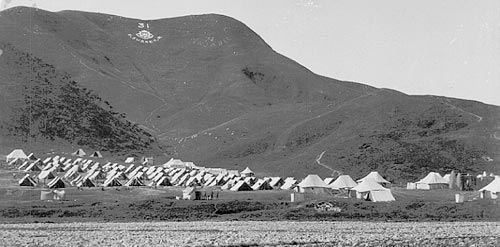Two weeks at Lo Wu
1925
Under the above heading an unidentified officer, known only under the initials A E W., describes in an edition of the East Surreys Journal a two week attachment which he spent in camp with the 1st Battalion of the Regiment at Lo Wu in China in February 1925.
Travelling by train from Hong Kong, and asking where to get out, he was told "Oh, tell the guard to stop at bridge 47 and the camp is about five minutes walk from the bridge". The instructions proved accurate and on disembarkation the writer could see the pleasantly situated camp which was sited on a gentle slope. It was easily identifiable by the presence behind it of a large Regimental badge made of whitewashed stones laid by pioneers and measuring 40 feet from top to bottom.
The tented camp was about 25 miles north of Kowloon and close to a railway line whose services, at that particular time were restricted due to internal unrest. Most of the surrounding country consisted of high hills which surmounted paddy fields devoted to the growing of rice. Flooded during the growing season, the fields were allowed to dry out in the "off" season and the East Surreys, taking advantage of such a period, had constructed a parade ground on the terrain. One grim aspect of the hills was that they were used as Chinese burial grounds with not all parts of bodies being completely interred.

Lo-Wu camp 1925
Villages were described as being picturesque but pleasure to the eyes were sometimes marred by opposite effects to the nose caused by the presence of large numbers of dogs and pigs. Added colour was still apparent in the villages due to the celebrations of the Chinese New Year in the previous month. Although in a remote place the camp managed to supply some entertainment for its occupants in the shape of cinematograph shows, the necessary electrical power being effected by a manually turned generator. As the evenings were generally cold the audiences usually sat around in greatcoats with additional warmth provided by charcoal braziers. Training programmes were busy and varied and the writer was able to view them from different angles and at different levels of command. Live ammunition was used on occasions so the local populace were well advised to "keep their heads down". One interesting combined operations exercise involved embarkation of troops in HMS Despatch and later disembarkation under cover of smoke screens effected by dropping cannisters into the sea. (Despatch was a "D" class cruiser who later acted as a Headquarters ship in the Normandy landings in 1944 with members of 4th Queen's on board in an anti-aircraft capacity manning Bofors guns). The marches of the troops through Chinese villages always roused the interest of the inhabitants but one occasion the feeling was reciprocated when sounds of a gramophone playing jazz music were heard coming from a house. The proud owner invited the writer in to see the machine and then brought it outside to entertain the rest of the Company. But all too soon the fortnight's attachment passed and AEW found himself back at Bridge 47 to catch the return train to Hong Kong, leaving behind him a well organised Regiment and camp from which he took away many happy memories.
Related
